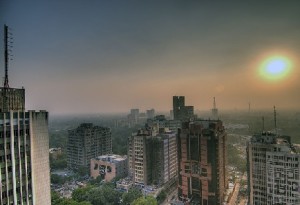Amidst recent reports of incredibly high rates of pollution in Chinese cities, especially Beijing, other Asian cities’ pollution levels are being heavily overshadowed. In fact, Hong Kong, New Delhi, Ulaanbaatar, and Dhaka all actually rank higher on the pollution index compiled by the World Health Organisation (WHO), and pollution is increasingly posing different problems for each of these rapidly developing world cities.
Over the past few days, Beijing’s air pollution has again soared to ‘hazardous’ levels according to US embassy air quality monitors . People were warned to stay indoors, and are being forced to make changes to their normal routines to avoid the worst of the smog. Following a recent drop in airborne toxins, these dangerously high levels of pollution are returning just in time to welcome some of China’s top leaders to the 12th National Party Congress in Beijing.
Hong Kong had the same problems over the past weekend, with readings at different locations measuring 183, 193 and 137 on a scale where 100 reads as ‘very high’ and anything above 200 is ‘severe’. Reports have voiced concern towards authorities in Hong Kong that their lack of control over pollution is threatening Hong Kong’s competitiveness as an economic hub, as it is difficult to attract and keep talent, especially foreign, in Hong Kong. Official reports have estimated that smog is responsible for about 3,200 premature deaths per year.
while Beijing’s government has tried to cut down on the amount of cars on the roads, and shut down factories, New Delhi’s government has not introduced any measures
In New Delhi, unlike in Beijing, the government is not yet acknowledging and acting on the problem of pollution. Pollutant particles, known as PM 2.5, which can get into the bloodstream through the lungs, measured over 400 micrograms per cupid meter in a couple of neighbourhoods in and around New Delhi last Thursday. This compares to Beijing’s reading of 172 micrograms per cubic meter. However, while Beijing’s government has tried to cut down on the amount of cars on the roads, and shut down factories, New Delhi’s government has not introduced any measures, nor warned its citizens to limit outdoor activities.
In the case of Ulaanbataar, a study by Ryan Allen at Simon Fraser University has shown one in ten deaths in the capital to be caused by the air pollution. Research has demonstrated that air pollution causes respiratory illness and cardiovascular issues, which are major problems in Mongolia at the moment. Problems in this city are especially bad during winter, when more coal is burned to heat up the city and the pollution gets trapped in the mountains.
The main challenge for all these cities is how to sustain their economic development without damaging the environment further, needlessly damaging people’s health and standards of living
Similar trends and issues are seen in Bangladesh’s Dhaka, where thousands of premature deaths are attributed to air pollution. Economic growth and development in this large metropolis has lead to an increase in vehicles and construction sites from 2004 onwards, causing more contaminants to be released into the air in the city.
The main challenge for all these cities is how to sustain their economic development without damaging the environment further, needlessly damaging people’s health and standards of living. Historically, when Europe went through the industrial revolution, pollution levels were also at the hazardous levels seen across Asia today. However, government intervention and international environmental laws have cleaned up Europe’s air. This is the aim for some of Asia’s biggest cities too, but transnational cooperation is required to continue rapid economic development while sustaining the environment and keeping air pollution at lower levels.
By Margaux Schreurs




